A healthy sufficient amount of organic matter is 1.29%, whereas soils in Pakistan fall within a wide range from 0.52 to 1.38%, with most soil falling lower than 1% in organic matter. Let’s dive into this series on Pakistan’s agricultural landscape by talking about one of the basics of crop production: soils in Pakistan. Broadly speaking, what do crops need to grow? It depends non-exhaustively on climate, adequate water supply and our soil surface.
We’ll start with where our crops spring from and burrow their roots in. Due to the geographic spread and diversity of our country’s soils – we will focus on the big picture. We’ll see what defines our soils by identifying the characteristics that are common amongst them.
Instead of taking on a textbook approach, we will start by putting our readers in the shoes of a progressive farmer who has recently taken charge of his landholding. Naturally, the farmers first question before planting their crop will be to see the quality of their piece of land and how fertile it is. In most areas, they will be able to give a sample to their district lab for a test. However, before we get into what the results of a soil test will provide, it is important to understand that most small farmers do not have access to soil tests in Pakistan.
Only 18% of farmers in Sindh and 28% in Punjab have availed soil tests in the past. Most rely on traditional knowledge passed down generations to determine what crops to grow. As we go along this topic, we will give our readers a primer on the metrics we used to evaluate the characteristics of soils in Pakistan. At Macro Pakistani, our aim for the first part of this series is for our reader to understand a basic soil test from a farmer’s point of view.

Types of Soils
At the risk of losing nuance, we will first discuss what differentiates soils in different areas from one another before discussing similarities. Broadly, they are four types of soils:

For starters, sandy soils are made of small rock particles with poor water and nutrient retention, making for poor agricultural potential. Amongst other areas, these soils extend over the deserts of Thal, Thar, Cholistan and parts of western Balochistan. Sandy soils can be reclaimed through various farming methods.
Silt soils have particles smaller than sand but larger than clay. They have good water retention and are generally fertile, allowing for crop production. They are found along the river banks in the Indus Basin.
Clay soils have the smallest particles and the soil is tightly packed together densely without air in the middle. It stores water and does not allow for easy drainage. This waterlogging potential generally makes it less than ideal for most crops.
Loamy soils retain water and nutrients well, making them ideal for farming. All most commonly grown crops in Pakistan are best suited to this soil: vegetables, pulses, oilseeds, cotton, wheat and sugarcane.
Most soils are a combination of the above four and take different aspects of each other. Their properties can be altered through farming techniques and application of manure.
Soil Organic Matter
Now we will return to what is common amongst soils in Pakistan. We can start with what is arguably the most important factor in plant growth: Soil Organic Matter (SOM). SOM comes from decomposed matter and improves fertility by facilitating the absorption of plant nutrients.
A healthy sufficient amount of organic matter is 1.29%, whereas soils in Pakistan fall within a wide range from 0.52 to 1.38%, with most soil falling lower than 1% in organic matter. as the maps below for Punjab and Sindh show, only one district in Pakistan, Kambar-Shahdadkot, has fertile soil. All other districts across the two provinces have weak or very weak organic matter in soil. Our commonly arid climate results in rapid decomposition of organic matter and loss of SOM is increased by lack of replenishment. This lack of fertile soil alone makes it an uphill task for farmers to practice agriculture.
District-wise average Soil Organic Matter
Most soils in Pakistan have less than 1% organic matter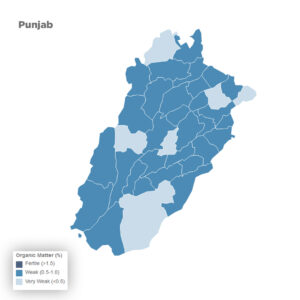
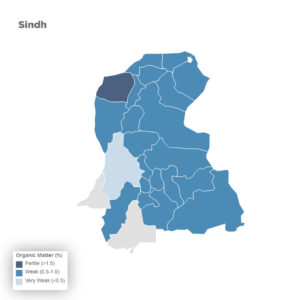
Source: FAO Pakistan; Fauji Fertilizer Company Limited
Our challenge of low SOM in soils in Pakistan is further intensified by conducting unsustainable intensive agriculture. Intensive agriculture involves high density farming, increased cropping frequency and leaving little to no periods where land is fallow. If nutrients and SOM are not replenished, intensive farming can lead to low yields.
Sources of Soil Organic Matter (SOM)
On farms, the main sources of organic matter are plant litter (e.g. roots, stubbles) and animal manures. As a result, cereal crops such as wheat, maize and rice benefit soil organic matter as they leave behind their roots and stubbles. Filter cake or mill mud from sugar mills is also a source of organic matter and nutrients.
Farmyard manure (FYM) is one of the best sources of organic matter, which mainly comes from livestock dung. Data is scarce on the use of FYM due to the difficulty of surveying large numbers of farmers.
Based on rough estimates by FAO, almost half of animal waste is not collected, and of the recovered amount – half is further used as fuel. As a result, only about a quarter of animal waste is available to enhance SOM in Pakistan.
There are other farming techniques that can prove to be successful interventions. Green manuring is a good example, where ploughing grown crops, especially legumes, improves SOM. However, most farmers do not see short term economic advantages to this and are stubborn about adopting these practices.
According to the Food and Agriculture Organization (FAO) of the United Nations in Pakistan – farmers in Pakistan put less of SOM sources and more of NP fertilizers such as Urea and DAP. This can be partly explained because the nitrogen content (nitrogen is a vital macronutrient for plant growth) in manures is both highly variable and generally low.
Soil pH and Alkalinity
As a progressive farmer moves on to look at the rest of his soil test, acidity or alkalinity will be one of the main other items. Soil pH is the measure of how acidic or alkaline the soil is. Soils in Pakistan are largely considered to be alkaline. In general, this means that the soil has a pH greater than 7.5.
How does this affect crop growth? Soil pH influences the nutrient quantity that is soluble in the water held in the soil. This, in turn, affects how much of the nutrients can be taken up by crops. The sweet band in which nutrients are readily available to plants is between 5.8 to 6.5 (even up to 7.5) and most of the soils in Pakistan have soil pH a lot higher than this ideal range, often crossing 8.5 soil pH.
What interventions can be taken to combat high soil pH? Soil pH in a technical sense cannot be changed, it is fixed. However, some interventions can temporarily reduce the pH of the top soil allowing for nutrient uptake to improve.
Luckily, this gap is already being bridged by a lot of private sector fertilizer companies. Fertilizers such as Ammonium Sulphate (AS) help amend the soil to control pH. The average cash-strapped farmer’s default inputs are Urea and DAP that they use as a price benchmark. Urea retails at PKR 1,600 to 2,000 for each 50 kilo bag. If fertilizers with sulfur such as Ammonium Sulphate retail at a similar price, fertilizers with sulfur could compete to be a default input.
We will talk thoroughly and exclusively about fertilizers in the larger context in our next post on soil and plant nutrition.
Provision vs. Uptake
The average farmer spends a good amount of his farming input budget on fertilizers. However, due to a general lack of awareness farmers confuse ‘nutrient provision’ with ‘nutrient uptake’. The former is how much of a certain nutrient is applied on the land, while the latter involves how much is taken up by the crop.
As a result of this confusion a farmer may spend large amounts on fertilizer, but most of the nutrients will not be taken up due to their soil pH not being in an ideal range. In the absence of any intervention, farmers will lose out on efficient soil nutrition management strategies.
A partial problem of this is that it is difficult to measure plant nutrient uptakeability due to a lack of measuring facilities that use methods like leaf analysis. However, we will leave that for our later post on innovations in agriculture.
Soil Electrical Conductivity (EC)
Soil electrical conductivity (EC) is a measure of the salinity of the soil, a good proxy for identifying crop health. It is used as a measure since pure water does not conduct electricity, but the salts present in most water allow conductivity. This conductivity is proportional to how much salt is in the water. The soil’s health is further closely connected to yield and crop suitability. EC is related to both natural causes and changed by cropping practices.
Salinity is damaging for crop production due to various reasons. Since levels of salts in water regulate water movement through osmosis, water can go back from plant roots into soil causing dehydration. Salinity can also affect the uptake of nitrogen, the most important nutrient for crop growth. It also reduces soil microbial activity – which converts organic matter into available nutrients through mineralization.
Southern Punjab and most of Sindh appear to have significant build-up of salt
Source: FAO Pakistan; Fauji Fertilizer Company Limited
District-wise average Electrical ConductivitySouthern Punjab and most of Sindh appear to have significant build-up of salt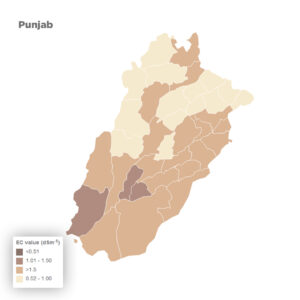
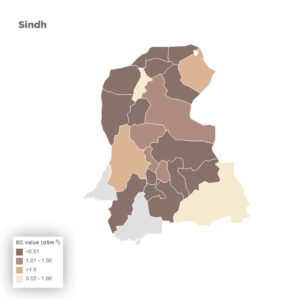
Source: FAO Pakistan; Fauji Fertilizer Company Limited
Naturally, in areas that have high rainfall, soluble salts that originate from weathering of minerals and rocks go directly into the groundwater systems or streams and carried away. On the other hand, in arid areas where there is low rainfall, salts accumulate at the top layers of the soil resulting in a high EC. As the map above shows, northern areas of Punjab have low EC (light brown) but as you move south, salt content increases (dark brown).
Waterlogging and Salinity
Waterlogging increases the salinity of the soil as waterlogged soils prevent leaching (draining) of the salts imported by irrigation water. Pakistan’s focus on sugarcane due to its high water consumption requirements (and to an extent, for rice) has resulted in growing waterlogging & rise in water table.
Agricultural experts have suggested that the left bank of the Indus could turn into lakes of saline water in 10-15 years. 90% of farmers in the area have been primarily cultivating rice and sugarcane for three decades. Their financial gain from cultivating from these crops will be lost as the land grows barren and reduces yield.
In the Indus Basin Irrigation system, 43% of the land is classified as waterlogged with water tables up to depths of less than three meters. This affects a total of 7.1 million hectares of land. Poor drainage networks and lack of tubewells has exacerbated the situation. The issue of waterlogging is turning around 100,000 acres of land barren per annum.
A coherent and effective tubewell strategy to reduce the water table can go a long way to reduce this issue. This can include direct subsidies, financing schemes or government infrastructure schemes.
Next Week
In our next post, we’ll introduce soil nutrition and its connection to the large fertilizer sector. The primary three macronutrients needed for plant growth are Nitrogen (N), Phosphorus (P) and Potassium (K). Due to our abundant indigenous natural gas reserves that provide raw material for Urea (a source of N), it is the most commonly used fertilizer. Stay tuned for the next post where we will discuss how we tend to over-apply nitrogen (N) and under-apply other nutrients such as Potassium (K), and what this means for crop yields.



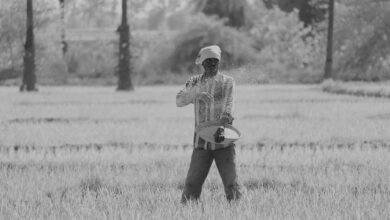
I need literature with comprehensive information for all crops/plants growing under pure sandy soils of 5ft depth surface soil.
Best regards